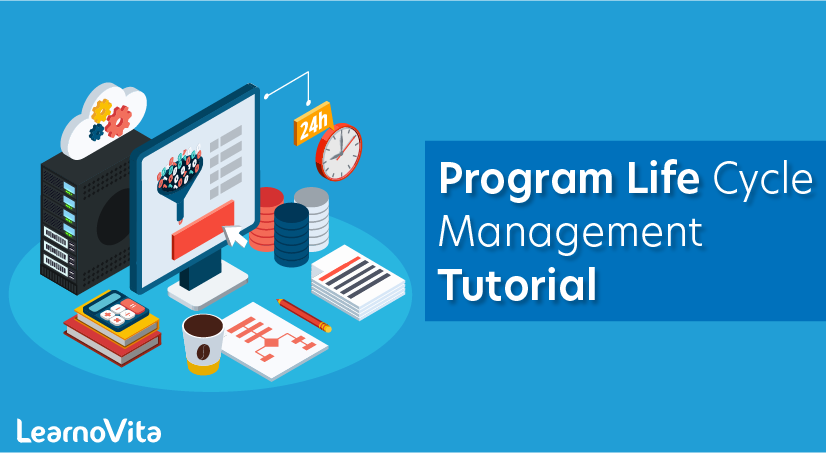
Program Life Cycle Management Tutorial
Last updated on 29th Sep 2020, Blog, Tutorials
What is a Program?
A program is a group of related projects, subprograms, and program activities that are managed in a coordinated way, to obtain benefits not available from managing them individually.
There are several important things to remember about this definition.
- The projects in a program are related to each other.
- They must be managed in a coordinated manner.
- The coordinated management of the projects must confer benefits not available from managing them individually.
Remember –
every large project with subprojects does not automatically become a program. It becomes a program only if there is a conscious effort to coordinate the management and deliver additional benefits.
In the subsequent sections, we are going to look at how these additional benefits result.
A large program may be potentially broken into smaller sub-programs.
A subprogram is a program that is managed within a larger program.
Now, the “components” within a program may include work elements of the program, the projects within a program, and also the “other work” that is managed within the program. The other work could be activities outside the projects, within a program.
For example,
operation elements, training, management activities, etc.
It is important to differentiate project work from regular operational work.
For example,
your office receptionist does the same work every day of picking any incoming call and directing the call to the right person in the office. This is ongoing, repetitive work and can be classified as “Operation.”.
Operations –
unlike projects, are neither temporary nor unique. Although projects and operations are distinct and do not overlap, programs may contain operations as part of the “other work.”.
We will find out what program management is in the following section.
Subscribe For Free Demo
Error: Contact form not found.
Definition of Program Management
The standard for program management defines program management as “the application of knowledge, skills, tools, and techniques to a program to meet the program requirements and to obtain benefits and control not available by managing projects individually”.
In simpler terms, program management is a process of managing multiple associated projects to enhance the performance and accomplish the goals of an organization.
These related projects, along with the subtasks and linked activities, are grouped and aligned as a program, to gain maximum benefits and profits for the organization.
Any program will have projects, but it is not mandatory for a project to be an integral part of a program. It is essential to obtain and apply the required skill sets, knowledge, toolsets and the strategies to be adopted to meet the requirements of a program and this is achieved by applying the program management techniques.
Let us continue to discuss program management in the next section.
Key Focus of Program Management
The common outcome and potential aspects are the key elements which define the link between associated projects in a program.
On the other hand, effort management is deemed to be the function of the project rather than the program, if the projects of a program are linked based on common resource sharing techniques, technology or shared client.
The key focus of program management is to identify the interdependencies of the linked projects and ascertain an optimal approach to manage them.
The key factors that influence the interdependencies between projects of a program include:
- Conflict management and extensive resource sharing techniques among the related projects
- Settling any consequences of changed management in a shared and structured organization
- Aligning the strategic directions that affect the objectives of the program’s projects and avoiding any future conflicts
Example of Program Management
Let’s consider an example of program management.
The Quality Management department of an organization which ensures quality products are delivered to the customers can be considered a typical example of program management as it involves various integrated functions (projects) such as planning, scrutinizing, implementation and evaluation.
Acquiring a company and integrating it with an existing organization is also an example of program management as it involves personnel management, many training sessions, implementing marketing strategies, dealing with different clients and so on.
Role of Program Manager
A program manager works within the five program management performance domains. Now, let us look at the role of a program manager.
Some of the key roles are that a program manager:
- Interacting with each project manager
- Ensuring each component team completes work, and integrates to deliver program end product, service, result or benefits
- Checking that the projects are organized, executed in a consistent manner, and fulfilled within established standards
- Addressing issues systematically and effectively during the program
Responsibilities of a Program Manager
Program Managers have greater responsibilities in the organization when compared to other people because they deal with multiple projects, and are liable for any consequences of developing in the entire program.
There are multiple projects pertaining to a single program, and it is the prime duty of the Program Manager to supervise the activities of all the projects and contribute to the success of the program.
The Program Manager works in developing the organization’s standards and aims at effectively and efficiently incorporating these standards into the program.
Some of the key factors that highlight the role of Program Managers are as follows:
Span of Control:
The Program Manager deals with many projects associated with a program. Hence, he checks the compliance to standard procedures by all the team members of the related projects of an entire program.
People Management:
The primary task of a program manager is to deal with clients and people possessing higher leadership degrees in the organization.
Decision Making:
The program managers are involved in making strategic decisions which aid in providing benefits to the organization.
Budget and Finance Management Skill Sets:
The Program Manager should be conversant with finance management as he is involved in estimating the cost for the program as well as the capital budgets involved in executing the program.
Allocation of Resources:
The Program Manager is involved in allocation and optimization of resources across all related projects of a program.
Most books and guides on program management written in the last 10 years have suggested program ‘phases’, which are simply transpositions of the project linear perspective. This view can jeopardise the effectiveness of program management and its capability to deliver strategies. Although it is now agreed that the objective of programs is to produce business level benefits by linking the strategy and projects, little management rhetoric has made its way into the program management literature and practice.
Recently, both the UK Office of Government Commerce (OGC) with Managing Successful Programmes and the Project Management Institute (PMI) with Standard for Program Management have aimed to clarify the lifecycle of the program and distinguish it from the project lifecycle. Below are diagrams that represent my own interpretation of the lifecycles that are described in these guides/standards.
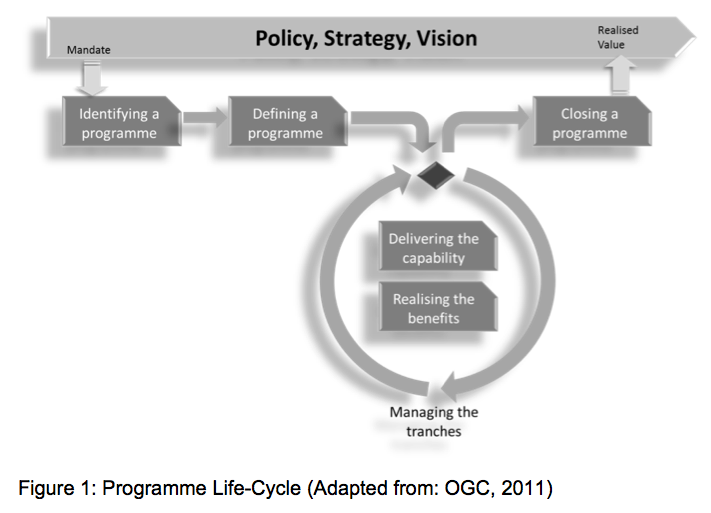
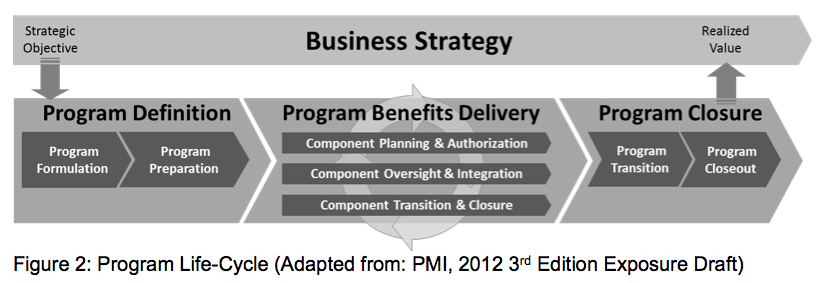
In both cases the cycle concerns mostly the delivery of benefits where, as you go along, you could review objectives in regard to emergent inputs, what the PMI calls “adaptive change”.
On the other hand, current organisational best practice strategy is viewed as an ongoing process made of a series of choices aligned to a clear vision. A sound program management lifecycle should reflect this perspective and allow for feedback from the measure of benefits at operational level to the strategy itself. This type of program lifecycle can be summarised in five generic stages or processes:
- 1.The Formulation stage, which consists of the definition of the program’s expected benefits through a stakeholder analysis and the agreement on the program purpose and objectives, which can include a functional blueprint. This process is iterative.
- 2.The Organisation stage, which consists of the development of the program’s detailed business case and technical blueprint as well as operational procedures and structures. This process is iterative with the formulation.
- 3.The Deployment stage, which consists of the delivery of capabilities through the program’s constituent projects and other actions, including the transition into the business. This is a cyclical process.
- 4.The Appraisal stage, which consists of a program-level assessment of the benefits realisation and evaluation of the success of the transition to operational benefits. This is also a cyclical process.
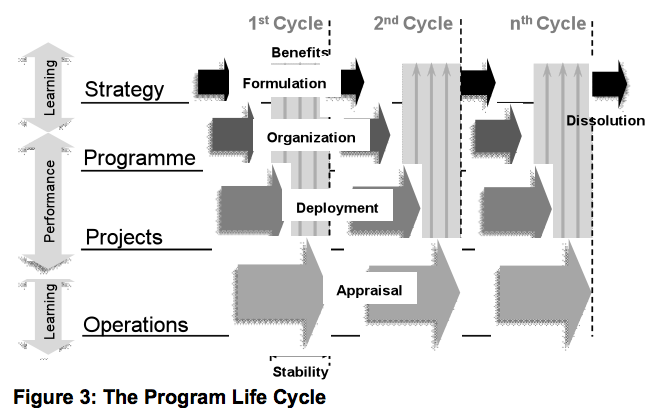
The program lifecycle diagram above exhibits the cyclical nature of programs where benefits are appraised on a regular basis and the resulting operational outcomes are used to realign the strategy, if required. Typically the cycles of the program lifecycle also correspond to periods of stability that enable the organisation to absorb change at a rhythm that corresponds to its culture. These periods of stability, which usually correspond to stage gates, are typically determined when pacing the program.
Whether you are an executive, a sponsor, a user, a program or project manager, guides and standards can be useful, but it is your responsibility as a program stakeholder to understand what your role in a program is and how program management can help your organisation achieve its objectives.
Program management is the link between the business strategy and the value it will generate when implemented. It is the process through which executives will be able to express their needs and make sure they are fulfilled.
Sponsors will be able to define the improvements they are expecting and clearly link them to the strategy to ensure they are realized and aligned with the business objectives. Program managers will understand how to support both executives and sponsors in a tangible way and how to deliver measurable results to the business. Project managers will understand how their role is essential to the program’s success. Finally, operational and technical users will be able to make sure the expected improvements are well integrated and produce the expected results.
In the same way we use project milestones to manage projects, we use program milestones to manage programs. Different organizations will have different program governance in place and therefore use different program milestones for their programs, but the milestones I want to look at today are those defined by the PMI, which map relatively easily to the milestones I’ve seen in use within different organisations. The program lifecycle defined by the PMI is shown below:
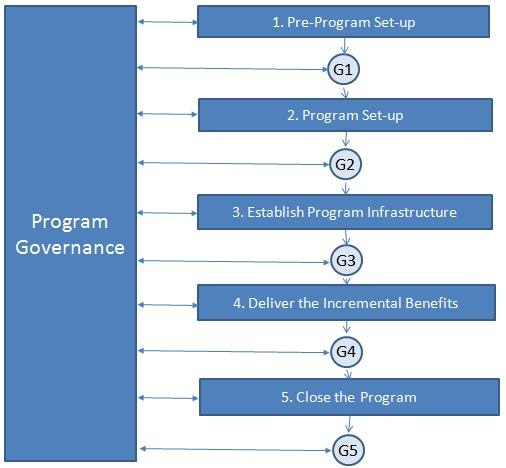
From the diagram above we can see that the program lifecycle consists of 5 key milestones (or gates), and thus 5 key phases which happen before each gate:
- 1.Pre-Program Set-up
- 2.Program Set-up
- 3.Establish the Program Management and Technical Infrastructure
- 4.Deliver the Incremental Benefits
- 5.Close the Program
Let’s look at each of these phases in turn, to see at a high-level what they entail.
1.Pre-Program Set-up
The main objective of this phase is to establish a firm foundation of support and approval for the program. This will include the following activities:
- Understanding the strategic value of the proposed change
- Identifying the key stakeholders and their expectations/interest
- Identifying the objectives of the program and aligning them with the organizations strategic objectives
- Developing a high-level business case to justify the program
- Securing approval to start the program
- Appointing a program manager to run the program
- Developing a plan to initiate the program
2.Program Set-up
At this stage the program has received “approval in principle” and we can move to set-up the program. During this stage we should:
- Complete the scope definition and planning
- Define the activities and sequence them
- Obtain duration estimates for all activities
- Create the high-level schedule
- Understand the resources we will use (internal or external, shared etc)
- Have a business case for each project in the program
- Identify risks and instigate the risk management process
- Identified the program team
- Approve the program plan based on the individual project business cases and any supporting evidence.
3.Establish the Program Management and Technical Infrastructure
This phase establishes the infrastructure that will support the program and its constituent projects as they deliver the expected benefits of the program. This will include the following:
- Program specific governance areas such as processes and procedures
- Program specific tools such as reporting, benefit measurement, software development tools etc.
- Program facilities
4.Deliver the Incremental Benefits
This is where most of the work gets done. In this phase we initiate the projects which comprise the program and deliver the incremental benefits. Key activities in this phase include:
- Initiating projects to deliver benefits
- Managing the transition from the current state to the new state
- Ensure projects meeting their business and technical requirements
- Assess progress against plan
- Constantly monitor for factors which may affect the program plan or the planned benefits
- Coordinate the dependencies between projects
- Identify and monitor risks including mitigation actions
- Identify and monitor issues and their corrective action
- Coordinate to ensure efficient use of resource
- Communicate with stakeholders
5.Close the Program
In this phase we shutdown the program in a controlled manner. This includes the following key tasks:
- Review the status of benefits with the stakeholders
- Disband the program organisation
- Document the lessons learned and initiate actions to rectify
The program life cycle phases overview
- Program Definition Phase. This phase consists of program activities conducted to authorize the program and develop the program roadmap required to achieve the expected results.
- Program Delivery Phase. Program delivery comprises the program activities performed to produce the intended results of each component in accordance with the program management plan.
- Program Closure Phase. This phase includes the program activities necessary to transition the program benefits to the sustaining organization and formally close the program in a controlled manner.
During program closure, the program is transitioned and closed or terminated early, or work is transitioned to another program.
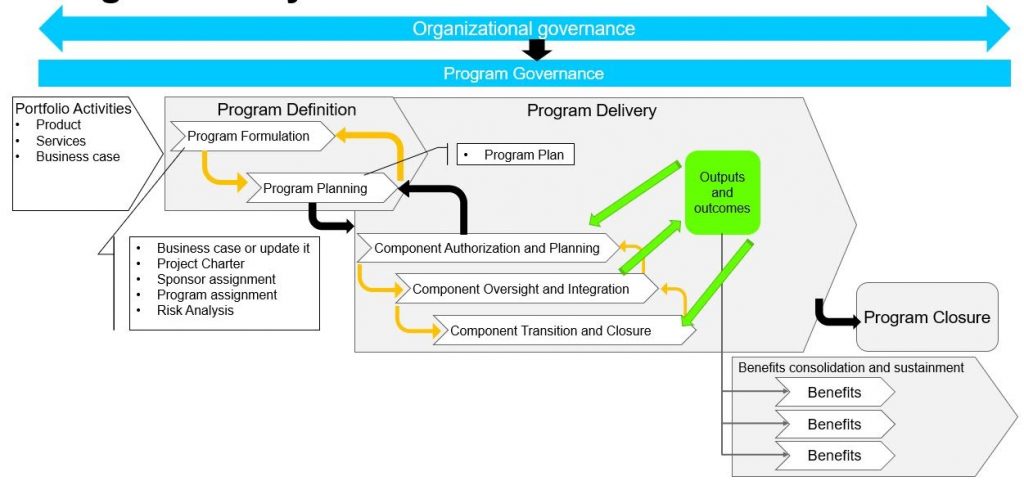
- The program definition phase includes program activities conducted to authorize the program and develop the program roadmap required to achieve the expected results
- There may be a number of activities executed by a portfolio management body prior to the start of the program definition phase.
- The primary purpose of the program definition phase is to progressively elaborate the goals and objectives to be addressed by the program, define the expected program outcomes and benefits, and seek approval for the program.
Program formulation includes:
- Initiate studies and estimates of scope, resources, and cost;
- Develop an initial risk assessment; and
- Develop a program charter and roadmap.
The candidate program is compared with other organizational initiatives to determine the priority of the program under consideration.
This analysis helps determine the probability of the program’s successful delivery of organizational benefits and helps identify risk response strategies and plans.
The contents of the program charter generally consist of the following questions and their answers:
- Justification. Why is the program important and what does it achieve?
- Vision. What is the end state and how will it benefit the organization?
- Strategic alignment. What are the key strategic drivers and the program’s relationship to the organizational strategic objectives and any other ongoing strategic initiatives.
- Benefits. What are the key outcomes required to achieve the program vision and benefits?
- Scope . What is included within the program and what is considered to be out of scope at a high level?
- Components. How are the projects and other program components configured to deliver the program and the intended benefits?
- Risks and issues. What are the initial risks and issues identified during the preparation of the program roadmap?
- Timeline. What is the total length of the program, including all key milestone dates?
- Stakeholder considerations. Who are the key stakeholders, who are the most important stakeholders,
- Program governance. What is the recommended governance structure to manage, control, and support the program?
Program Planning ,
commences upon formal approval of the program charter by the program steering committee. This plan is the key output created during program planning and may be combined into one plan or multiple plans that include the following subsidiary documents:
- Benefits management plan
- Stakeholder engagement plan
- Governance plan
- Change management plan
- Communications management plan
- Financial management plan
- Information management plan
- Procurement management plan
- Quality management plan
- Resource management plan
- Risk management plan
- Schedule management plan
- Scope management plan
- Program roadmap
Program delivery phase
includes program activities performed to produce the intended results of each component in accordance with the program management plan.
The program manager is also responsible for managing this group of components in a consistent and coordinated way in order to achieve results that could not be obtained by managing the components as stand-alone efforts.
Each program component will progress through the following program delivery sub-phases:
- Component authorization and planning: involves the initiation of components based on the organization’s specified criteria and individual business cases developed for each component. These criteria are generally included in the program governance plan. The Program Governance Performance Domain provides guidance for processes leading to component authorization.
- Component oversight and integration . In the context of a program, some components may produce benefits as individual components, while other components are integrated with others before the associated benefits may be realized. Each component team executes its associated plans and program integrative work. Throughout this activity, components provide status and other information to the program manager and to their associated components so their efforts may be integrated into and coordinated with the overall program activities
- Component transition and closure . After the program components have produced deliverables and coordinated the successful delivery of their products, services, or results, these components are typically scheduled for closure or transition to operations or ongoing work. Prior to the end of the program delivery phase, all component areas are reviewed to verify that the benefits were delivered and to transition any remaining projects and sustaining activities.
Program delivery ends when program governance determines that the specific criteria for this phase have been satisfied or a decision is made to terminate the program.
Program closure phase
includes program activities necessary to transition program benefits to the sustaining organization and formally close the program in a controlled manner.
During program transition, the program steering committee is consulted to determine whether:
(a) the program has met all of the desired benefits and that all transition work has been performed within the component transition, or
(b) there is another program or sustaining activity that will oversee the ongoing benefits for which this program was chartered.
2.Program activities and Integration Management
Program activities and integration management are concerned with collectively utilizing the resources, knowledge, and skills available to effectively deploy multiple components throughout the program life cycle.
This process also involves making decisions regarding:
- Competing demands and priorities,
- Risks,
- Resource allocations,
- Changes due to uncertainty and complexity of the program scope,
- Inter-dependencies among components, and
- Coordination of work to meet the program objectives
Program activities overview
All work performed in a program for the purpose of overall program management is collectively known as program activities.
It is important to note that program activities directly support the individual components to ensure the component activities help achieve the program objectives.
Program integration management
is the core activity that occurs across the entire program life cycle.
This section focuses on the following activities and when they are performed throughout the program life cycle phases:
a) Program infrastructure development
b) Program delivery management
c) Program performance monitoring and controlling
d) Benefits sustainment and program transition
e) Program closeout
a) Program infrastructure development its primary purpose is twofold. It establishes both the management and technical resources of the program and its components. This infrastructure refers to both personnel and to program specific tools, facilities, and finances used to manage the program.
Although the program manager is assigned during program definition, the program management core team is designated as part of establishing the program infrastructure.
For many programs, the program management office (PMO) is a core part of the program infrastructure. It supports the management and coordination of the program and component work.
An effective PMIS incorporates:
- Software tools;
- Documents, data, and knowledge repositories;
- Configuration management tools;
- Change management system;
- Risk database and analysis tools;
- Financial management systems;
- Earned value management activities and tools;
- Requirements management activities and tools; and
- Other tools and activities as required.
These resources are separate and distinct from the resources required to manage the individual components within the program
b) Program delivery management
includes the management, oversight, integration, and optimization of the program components that will deliver the capabilities and benefits required for the organization to realize value.
These activities are performed throughout the program delivery phase and relate to the initiation, change, transition, and closure of program components.
During the course of program delivery, change requests that fall within the program manager’s authority level will be approved or rejected to manage performance and any changes to the program management plan
c) Program performance monitoring and controlling
are performed by both program- and project-level components during delivery management.
- These activities include collecting, measuring, and disseminating performance information to track progress against the program objectives and assess overall program trends.
- Typical outputs of this ongoing activity include program performance reports and forecasts. Program performance reports include a summary of the progress of all program components.
d) Benefits sustainment and program transition.
Some program components produce immediate benefits while others require a hand-off or transition to another organization in order for the ongoing benefit to be realized.
Benefits sustainment may be achieved through operations, maintenance, new projects, or other initiatives and efforts.
This activity transcends the scope of individual program components since this work is typically performed as the program is closed
e) Program closeout.
As part of the program governance plan, a final program report may be required to document critical information that can be applied to improve the success of future programs and component projects.
This final report may consist of:
- Financial and performance assessments,
- Lessons learned,
- Successes and failures,
- Identified areas for improvement,
- Risk management outcomes,
- Unforeseen risks,
- Customer sign-off,
- Reason(s) for program closeout,
- History of all baselines, and
- Archive plan for program documentation.
Upon program completion, knowledge transfer is performed when the program management team assesses the program’s performance and shares lessons learned with the organization.
Conclusion
We use milestones within the program governance to ensure we are where we need to be as the program is executed. It would be possible to write much more about each specific stage, but I hope this has given you enough of a flavour of each stage to enable you to apply this within your own organization.
Are you looking training with Right Jobs?
Contact Us- Program Governance Tutorial
- program strategy Alignment Tutorial
- Program Management Principles Tutorial
- Program Organization Tutorial
- Program Benefits Management Tutorial
Related Articles
Popular Courses
- MS Project Training
11025 Learners - PMP Certification Training
12022 Learners - Agile PLM Training
11141 Learners
- What is Dimension Reduction? | Know the techniques
- Difference between Data Lake vs Data Warehouse: A Complete Guide For Beginners with Best Practices
- What is Dimension Reduction? | Know the techniques
- What does the Yield keyword do and How to use Yield in python ? [ OverView ]
- Agile Sprint Planning | Everything You Need to Know

